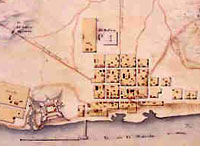How Did West Virginia Get Its Name?
West Virginia native Catherine Moore looks at how the state of West Virginia got its name.
West Virginia native Catherine Moore looks at how the state of West Virginia got its name.

Migration, both forced and voluntary, remains a prominent theme in African American history. This website is built around the history of 13 African American migration experiences: the transatlantic slave trade (1450s1867), runaway journeys (1630s1865), the domestic slave trade (1760s1865), colonization and emigration (17831910s), Haitian Immigration (17911809), Western migration (1840s1970), and Northern migration (1840s1890).
Twentieth-century migrations include the Great Migration (19161930), the Second Great Migration (19401970), Caribbean immigration (1900present), the return South migration (1970present), Haitian immigration in the 20th century (1970present), and African immigration (1970present). More than 16,500 pages of texts, 8,300 illustrations, and 67 maps are included. An interactive timeline places migration in the context of U.S. history and the history of the African Diaspora.

Transcriptions and images of more than 4,000 newspaper advertisements for runaway slaves and indentured servants between 1736 and 1803 can be browsed or search on this website. The runaways are primarily from Virginia, but also come from states along the Eastern seaboard and locations abroad. Materials include ads placed by owners and overseers as well as those placed by sheriffs and other governmental officials for captured or suspected runaway slaves. Additional advertisements announce runaway servants, sailors, and military deserters.
"Exploring Advertisements" offers browse, search, and full-text search functions, as well as maps and timelines for viewing the geographic locations of slaves. The site also provides documents on runaways—including letters, other newspaper materials, literature and narratives, and several dozen official records, such as laws, county records, and House of Burgess journals. Information on the currency and clothing of the time, a gazetteer with seven maps of the region, and a 13-title bibliography are also available.
Roanoke Island Festival Park is a 27-acre state historic site and cultural center celebrating history, education, and the arts. Visitors can step aboard the Elizabeth II, a representative 16th-century sailing vessel; visit with Elizabethan explorers and soldiers in the Settlement Site; tour the Roanoke Adventure Museum, which explores 400 years of Outer Banks history; and view the docudrama, "The Legend of Two-Path."
The park offers exhibits, tours, demonstrations, performances, educational programs, research library access, and recreational and educational events (including living history events).
Donald L. Miller, with Stephen Ambrose; Virginia Scharff; Waldo E. Martin, Jr.; Pauline Maier; Louis P. Masur; and Douglas Brinkley, explores the pre-Contact and contact history of the Americas, beginning with the Ice Age migrations, through the corn civilizations of Middle America, to the explorations of Columbus, de Soto, and other Spaniards.
Fort King George is the oldest English fort remaining on Georgia's coast. The fort was in operation from 1721 until 1736, when it was abandoned. Later, in the 19th century, the location was used as a major export center for lumber. Today, visitors can explore the reconstructed Fort King George, as well as three sawmills and tabby ruins which showcase the history of the location as a lumber exporter. The site is also home to a museum.
The fort offers visitors guided tours, interpretive events, a brief historical film, and a variety of exhibits and special events. The website offers a link to the Georgia Teacher's Resource for Touring Historic Sites, specific lesson plans for touring Fort King George, a brief history of the fort, a 15-photo photograph gallery, an event calendar, and visitor information.
During the French and Indian War (17541763), the British colony of South Carolina felt threatened by French activities in the Mississippi Valley. To counter this threat, the colony sent the Independent Company of South Carolina to construct and garrison what became Fort Loudoun. This move helped to ally the Overhill Cherokee Nation in the fight against the French and guaranteed the trade would continue between the Cherokee and South Carolina. In the course of the fort's four-year existence, relations between South Carolina and the Cherokee Nation broke down. In August, 1760, the Cherokee captured Fort Loudoun and its garrison.
Today, the fort offers tours and occasional living history events.

This bilingual website (English and French) explores the history of the French presence in North America from the early 16th century to the end of the 19th century through more than 360 manuscripts, books, maps, and other documents. Each thematic presentation—"Exploration and Knowledge," "The Colonies," "Franco-Indian Alliances," "Imperial Struggles," and "The French and North America after the Treaty of Paris"—includes a title exhibit and additional exhibits that highlight particular items in the collection. Materials can also be browsed in the collections section.
A timeline (15151804) organizes events in French America by explorations, colonization and development, and conflicts and diplomacy, and places them in the context of events in France. Additionally, there are eight descriptive maps that show various Indian groups in contact with the French and the changes in political boundaries in North America from before 1763 to the era of the Louisiana Purchase.

Designed to showcase the work of archaeologists and their excavations at Mobile and elsewhere in Alabama, this website offers images and exhibits from several digs. Visitors can "virtually visit" archaeological sites in the town of Old Mobile, capital of the French colony of Louisiane [sic] from 1702 to 1711; the Mississippian Indian city of Bottle Creek (11001400); and the Indian fishing site of Dauphin Island Shell Mounds (11001550).
Additional sites include the French village of Port Dauphin (17021725); the Dog River Plantation site, home to a French-Canadian immigrant family, numerous Indians, and slaves (1720s1848); and sites in downtown Mobile, including a Spanish colonial house (ca. 1800), an early 19th-century riverfront tavern, and antebellum cotton warehouses.
Artifacts features more than 250 images of pottery shards with accompanying descriptions. Great Links presents 30 additional websites that focus on preservation, archaeology, and Alabama history. The site also includes images and information on seven additional French colonial sites in Nova Scotia, New York, Michigan, Illinois, Mississippi, and Louisiana.

The images in this collection, focusing on the Americas, come from books printed or created in Europe between about 1492 and 1825. Images include woodcuts, copper engravings, and paintings. The database, still being compiled, currently contains 6,685 images and will eventually contain some 7,500 images. Image viewing software is available from the site.
The visitor can browse the entire archive or search by time period, geographical area, keyword, or subject, including indigenous peoples, flora and fauna, artifacts, industry, human activities, geography, maps, city views and plans, and portraits. Some images, such as Ptolemy's map of the world, may be familiar. Others are reproduced for the first time. Navigation requires some practice, but is worth the effort.